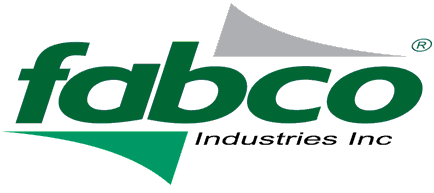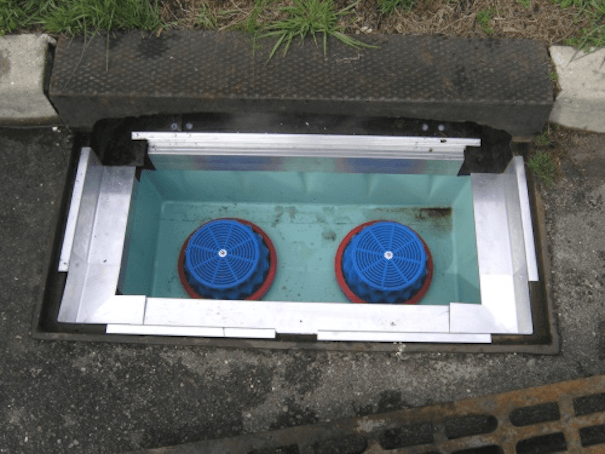Filter Cartridge Catch Basin Insert Project in PA
In cooperation with the Berks County Pennsylvania Conservation District (BCCD), Fabco and Exeter Supply Company, its Eastern PA product distribution partner, installed a StormBasin™ Filter Cartridge Catch Basin Insert to demonstrate its operation and maintenance as a decentralized stormwater retrofit best management practice (BMP).
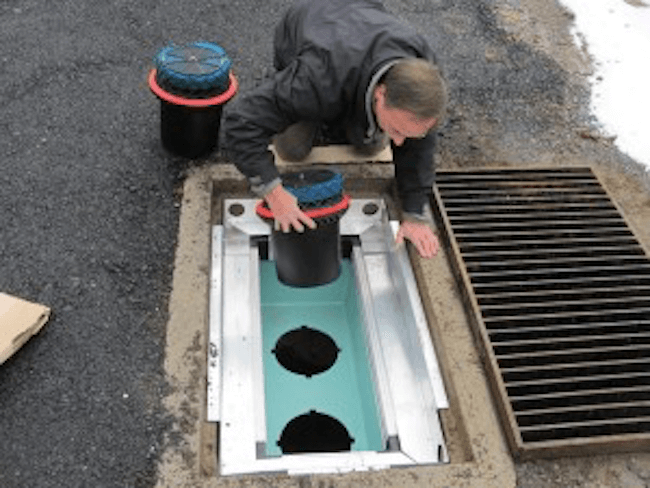
In February 2013, a 2-cartridge StormBasin™ filter cartridge catch basin Insert was installed into a drop inlet catch basin in the parking area of the conservation district’s offices in Leesport, PA as a component of the district’s innovative effort to develop and maintain a stormwater BMP interpretive trail. The trail was developed to educate visitors about stormwater management, non-point source pollution and BMP strategies for reducing water pollution that can be implemented at home, at work, or in the community.
After observing the installation process, the BCCD staff monitored the function of the StormBasin™ Filter Cartridge Catch Basin Insert under different seasons, climates and types of precipitation events. The BCCD later facilitated a maintenance demonstration with Fabco and Exeter during a Stormwater Retrofit Training Session for stormwater managers and engineering consultants led by the non-profit Center for Watershed Protection (http://www.cwp.org/) in October 2013.
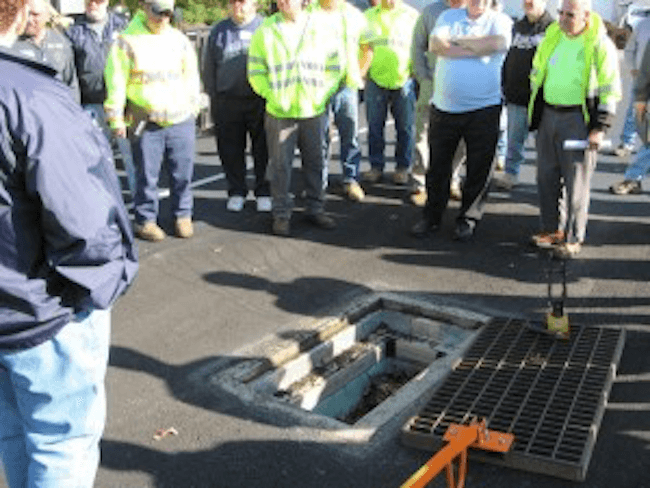
The StormBasin™ Filter Cartridge Catch Basin Insert maintenance demonstration (Click Here for video) included removing collected sediments, floatables and debris from the insert using vactor equipment, changing the filter cartridges, and estimating the amount of material captured by the insert and filters over a 9 month time period utilizing a weight scale. Fabco generally recommends biannual clean out of inserts and an annual change of filter cartridges.
The StormBasin™ was observed to have functioned as designed during the demonstration period and there were no reported issues with flow even during high volume precipitation events due to its hooded bypass design. A number of maintenance demonstration observers noted the amount of stormwater pollutants that were captured by the insert and filter cartridges in just 9 months while others commented on the speed of cleaning out the insert using vacuum equipment and replacement of filter cartridges.
Fabco applauds the BCCD (http://berkscd.com/) for taking the initiative to demonstrate various stormwater management practices in the field through its BMP interpretive trail and to provide increased educational opportunities for communities to learn about innovative stormwater practices.
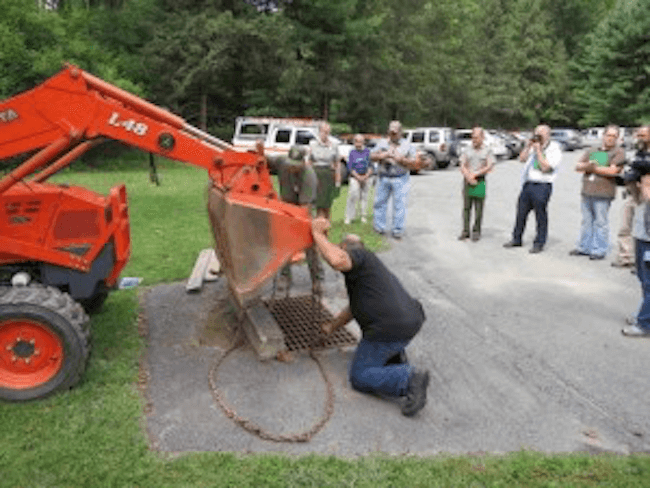
Filter Cartridge Catch Basin Insert Reference
Catch basin inserts are a general category of proprietary devices that have been developed in recent years to filter runoff entering a catch basin. Catch basin inserts function similarly to media filters, but on a much smaller scale. Catch basin inserts typically consist of the following components: ❍ A structure (e.g. screened box, tray, basket,) which contains a pollutant removal medium
❍ A means of suspending the structure in a catch basin
❍ A filter medium such as sand, carbon, fabric, bag, etc.
❍ A primary inlet and outlet for the stormwater
❍ A secondary outlet for bypassing flows that exceed design flow. (Washington, 2000). The two basic varieties of catch basin inserts include filter trays and filter fabric. The tray design consists of a series of trays, with the top tray serving as an initial sediment trap, and the underlying trays composed of media filters. The filter fabric design uses filter fabric as the filter media for pollutant removal.
Depending on the insert medium, solids, organics (including oils), and metals can be removed. However, due to their small volume, catch basin inserts have very limited retention times and require frequent cleaning or replacement to be effective. Figure 11-S9-1 and Figure 11-S9-2 illustrate several examples of generic catch basin insert designs. Reasons for Limited Use
❍ Limited peer-reviewed performance data available. (See Chapter Six for a description of the recommended evaluation criteria and protocols for consideration of these technologies as primary treatment practices.) Treatment Practice Type Primary Treatment Practice Secondary Treatment Practice
● Stormwater Management Benefits Pollutant Reduction Sediment ■ Phosphorus ■ Nitrogen ■ Metals ■ Pathogens ■ Floatables ■ Oil and Grease ■ Dissolved Pollutants ■ Runoff Volume Reduction Runoff Capture ■ Groundwater Recharge ■ Stream Channel Protection ■ Peak Flow Control ■ Key: ■ Significant Benefit ■ Partial Benefit ■ Low or Unknown Benefit Suitable Applications Pretreatment ■ Treatment Train ■ Ultra-Urban ■ Stormwater Retrofits ■ Other ■ Source: City of Knoxville, 2001.
11-S9-2 2004 Connecticut Stormwater Quality Manual ❍ Require frequent maintenance and replacement. Can become a source of pollutants unless maintained frequently. ❍ Susceptible to clogging. Can aggravate flooding when clogged.
❍ Do not provide peak flow attenuation, runoff volume reduction, or groundwater recharge. Suitable Applications ❍ To provide pretreatment for other stormwater treatment practices. ❍ For retrofit of existing conventional catch basins that lack sumps or have undersized sumps. ❍ May be considered in specialized small drainage applications such as industrial sites for specific target pollutants where clogging of the medium will not be a problem.
❍ As temporary sediment control devices and pretreatment at construction sites. ❍ For oil control at small sites where the insert medium has sufficient hydrocarbon loading capacity and rate of removal, and the solids and debris will not prematurely clog the insert. ❍
Can be used in unpaved areas for inlet protection. Design Considerations Due to the proprietary nature of these products, catch basin inserts should be designed according to the manufacturer’s recommendations. Some general design considerations for catch basin inserts include:
High Flow Bypass: A high flow bypass or other design feature to allow stormwater runoff into the drain system in the event of clogging and runoff in excess of the water quality design flow to bypass the system without danger of local flooding.
Maintenance: Should be inspected and maintained in accordance with manufacturer’s recommendations. Since catch basin inserts require frequent inspection and maintenance, they should only be used where a full-time maintenance person is on-site.
Plans for catch basin inserts should identify detailed inspection and maintenance requirements, inspection and maintenance schedules, and those parties responsible for maintenance. Sediment Disposal: Sediment removed from catch basin inserts should be properly handled and disposed in accordance with local, state, and federal regulations. Before disposal, appropriate chemical analysis of the material should be performed to determine proper methods for storage and disposal.
